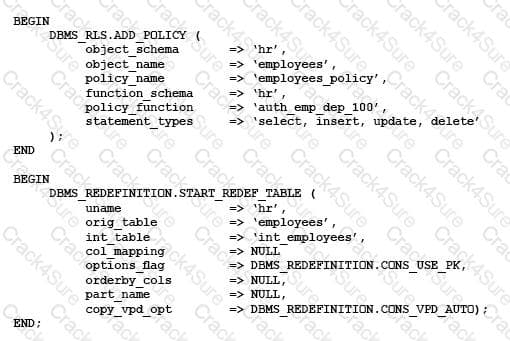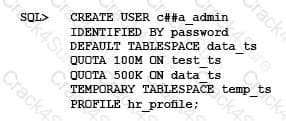We at Crack4sure are committed to giving students who are preparing for the Oracle 1z0-060 Exam the most current and reliable questions . To help people study, we've made some of our Upgrade to Oracle Database 12c exam materials available for free to everyone. You can take the Free 1z0-060 Practice Test as many times as you want. The answers to the practice questions are given, and each answer is explained.
Your multitenant container database, CDB1, is running in ARCHIVELOG mode and has two pluggable databases, HR_PDB and ACCOUNTS_PDB. An RMAN backup exists for the database.
You issue the command to open ACCOUNTS_PDB and find that the USERDATA.DBF data file for the default permanent tablespace USERDATA belonging to ACCOUNTS_PDB is corrupted.
What should you do before executing the commands to restore and recover the data file in ACCOUNTS_PDB?
You are administering a database stored in Automatic Storage Management (ASM). You use RMAN to back up the database and the MD_BACKUP command to back up the ASM metadata regularly. You lost an ASM disk group DG1 due to hardware failure.
In which three ways can you re-create the lost disk group and restore the data? (Choose three.)
You install a non-RAC Oracle Database. During Installation, the Oracle Universal Installer (OUI) prompts you to enter the path of the Inventory directory and also to specify an operating system group name.
Which statement is true?
Examine the commands executed to monitor database operations:

Which two statements are true? (Choose two.)
Which two statements are true about the use of the procedures listed in the v$sysaux_occupants.move_procedure column? (Choose two.)
Examine the following commands for redefining a table with Virtual Private Database (VPD) policies:

Which two statements are true about redefining the table? (Choose two.)
In your multitenant container database (CDB) that contains pluggable databases (PDBs), the HR user executes the following commands to create and grant privileges on a procedure:

How can you prevent users having the EXECUTE privilege on the CREATE_TEST procedure from inserting values into tables on which they do not have any privileges?
You Execute the following command to create a password file in the database server:
$ orapwd file=‘+DATA/PROD/orapwprod entries=5 ignorecase=N format=12’
Which two statements are true about the password file? (Choose two.)
Your multitenant container database (CDB) contains pluggable databases (PDBs), you are connected to the PDB HR_PDB. You execute the following command:

What is the result?
You plan to use the In-Database Archiving feature of Oracle Database 12c, and store rows that are inactive for over three months, in Hybrid Columnar Compressed (HCC) format.
Which three storage options support the use of HCC? (Choose three.)
In your database, the TBS PERCENT USED parameter is set to 60 and the TBS PERCENT FREE parameter is set to 20.
Which two storage-tiering actions might be automated when using Information Lifecycle Management (ILM) to automate data movement? (Choose two.)
In which two scenarios is an RMAN recovery catalog automatically resynchronized?
Your multitenant container database (CDB) is running in archivelog mode. Fxamlne this command and its output:

You issue this command in RMAN:
RMAN>BACKUP PLUGGABLE DATABASE "CDBSROOT", pdb2_l;
What is the outcome?
You are the DBA supporting an Oracle 11g Release 2 database and wish to move a table containing several DATE, CHAR, VARCHAR2, and NUMBER data types, and the table’s indexes, to another tablespace.
The table does not have a primary key and is used by an OLTP application.
Which technique will move the table and indexes while maintaining the highest level of availability to the application?
Your multitenant container database (CDB) contains some pluggable databases (PDBs), you execute the following command in the root container:

Which two statements are true? (Choose two.)
You are administering a database stored in Automatic Storage Management (ASM). You use RMAN to back up the database and the MD_BACKUP command to back up the ASM metadata regularly. You lost an ASM disk group DG1 due to hardware failure.
In which three ways can you re-create the lost disk group and restore the data? (Choose three.)
An Automatic Database Diagnostic Monitor (ADDM) finding in your production database reports that the shared pool is inadequately sized. You diagnose that this is due to the different kinds of workloads and this occurs only during peak hours. The following are the parameter settings for the database instance:

You want to balance the memory between the System Global Area (SGA) components depending on the workload.
Which option would solve this problem?
Oracle Data Redaction is active on the SCOTT.EMP table.
You queried the table twice.
SQL> SELECT ENAME, SAL, COMM, MGR, HIREDATE FROM EMP WHERE DEPTNO=30;

SQL> SELECT ENAME, SAL, COMM, MGR, HIREDATE FROM EMP WHERE DEPTNO=30;

Which is guaranteed to be true concerning the redaction policy?
You plan to use the Flashback Drop feature to recover the sales_emp table that was dropped in error. No other table with the same name exists in the sh schema, which owns the table. You query the recyclebin and find multiple entries for the salesemp table:

SQL FLASHBACK TABLE sale_emp To BEFORE DROP:
What would be the result?
You notice that the elapsed time for an important database scheduler job is unacceptably long.
The job belongs to a scheduler job class and runs in a scheduler window.
Which two actions could reduce the job's elapsed time? (Choose two.)
Examine the details of the Top 5 Timed Events in the following Automatic Workloads Repository (AWR) report:

What are three possible causes for the latch-related wait events? (Choose three.)
Which two statements are true about Oracle Managed Files (OMF)? (Choose two.)
You plan to drop the column of a table that has Flashback Archiving enabled.
You want to ensure minimal service disruption.
How would you do this in your Oracle 12c Database?
Which two statements are true concerning the Resource Manager plans for individual pluggable databases (PDB plans) in a multitenant container database (CDB)? (Choose two.)
You notice that the elapsed time for an important database scheduler job is unacceptably long.
The job belongs to a scheduler job class and runs in a scheduler window.
Which two actions could reduce the job's elapsed time? (Choose two.)
Which three statements are true about adaptive SQL plan management? (Choose three.)